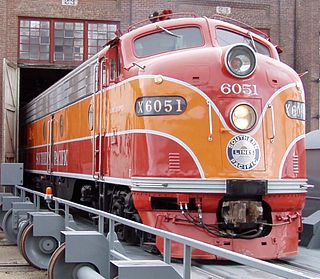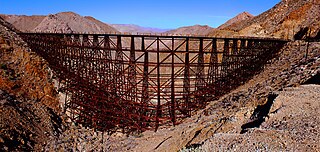
The Atchison, Topeka and Santa Fe Railway, often referred to as the Santa Fe or AT&SF, was one of the largest Class 1 railroads in the United States.

The California State Railroad Museum is a museum in the California State Parks system that interprets the role of railroads in the West. It is located in Old Sacramento State Historic Park at 111 I Street, Sacramento, California.

The San Diego and Arizona Railway was a 148-mile (238 km) short line U.S. railroad founded by entrepreneur John D. Spreckels, and dubbed "The Impossible Railroad" by engineers of its day due to the immense logistical challenges involved. It linked San Diego, its western terminus, with El Centro, its eastern terminus, where passengers could connect with Southern Pacific's transcontinental lines, eliminating the need to first travel north via Los Angeles or Riverside.

The San Diego and Arizona Eastern Railway Company is a short-line American railroad founded in 1906 as the San Diego and Arizona Railway (SD&A) by sugar magnate, developer, and entrepreneur John D. Spreckels. Dubbed "The Impossible Railroad" by many engineers of its day due to the immense logistical challenges involved, the line was established in part to provide San Diego with a direct rail link to the east by connecting with the Southern Pacific Railroad lines in El Centro, California.

The Coast Daylight, originally known as the Daylight Limited, was a passenger train on the Southern Pacific Railroad (SP) between Los Angeles and San Francisco, California, via SP's Coast Line. It was advertised as the "most beautiful passenger train in the world," carrying a particular red, orange, and black color scheme. The train operated from 1937 until 1974, being retained by Amtrak in 1971. Amtrak merged it with the Coast Starlight in 1974.

Carrizo Gorge Railway, Inc. was a railroad operator on the San Diego and Arizona Eastern Railway (SD&AE) from Tijuana, Mexico, to Plaster City, California.

Atchison, Topeka and Santa Fe 3751 is a class "3751" 4-8-4 "Heavy Mountain" type steam locomotive built in May 1927 by the Baldwin Locomotive Works in Eddystone (Philadelphia), Pennsylvania for the Atchison, Topeka & Santa Fe Railway (ATSF). No. 3751 was the first 4-8-4 steam locomotive built for the Santa Fe and was referenced in documentation as type: "Heavy Mountain", "New Mountain", or "Mountain 4-wheel trailer". No. 3751 served in passenger duties until being retired in 1957.

Southern Pacific 6051 is an EMD E9 diesel locomotive. It was one of nine E9s built for SP by EMD in December 1954 for the Southern Pacific (SP).

Santa Fe Depot in San Diego, California, is a union station built by the Atchison, Topeka and Santa Fe Railway to replace the small Victorian-style structure erected in 1887 for the California Southern Railroad Company. The Spanish Colonial Revival style station is listed on the National Register of Historic Places and is a San Diego Historic Landmark. Its architecture, particularly the signature twin domes, is often echoed in the design of modern buildings in Downtown San Diego.

The GE 80-ton switcher is a diesel-electric locomotive model built by GE Transportation Systems. It is classified as a B-B type locomotive. It was designed for industrial and light switching duties around railheads and ports.
The Heart of Dixie Railroad Museum is the official state railroad museum of Alabama. Dedicated to the preservation, restoration, and operation of historically significant railway equipment, the museum is located at 1919 Ninth Street, Calera, Alabama, on I-65 approximately 30 miles (48 km) south of Birmingham.

The Grizzly Flats Railroad (GFRR) was a 3-foot narrow-gauge heritage railroad owned by Disney animator Ward Kimball at his home in San Gabriel, California. The railroad had 900 feet (274.3 m) of track, and was operated from 1942 to 2006. It was the first full-size backyard railroad in the United States.

La Mesa Boulevard station is a station on the Orange Line of the San Diego Trolley located in the San Diego suburb of La Mesa, California. It serves the dense nearby commercial area, as well as a variety of apartment buildings that surround the stop.

Southern Pacific Railroad 2467 is a preserved 4-6-2 “Pacific” type steam locomotive. Built by Baldwin in 1921, it was used by the Southern Pacific Railroad to pull passenger trains until it was retired from service in 1956. On July 25, 1960, it was donated to the city of Oakland, California, who had it placed on display at the Harrison Railroad Park. In July 1990 a restoration began by the Friends of the 2467, which later merged into the Pacific Locomotive Association. In June 1999 it was returned to operation and made an appearance at Railfair 1999. Although serviceable, SP 2467 is currently on static display while on loan from its operator, Pacific Locomotive Association, Inc., to the California State Railroad Museum in Sacramento, California.

The California Central Railway was incorporated on April 23, 1887, with headquarters in San Bernardino, California. George O. Manchester was the President of the corporation.

Southern Pacific Railroad (SP) 2353 is one of 10 heavy 4-6-0 'Ten Wheel' steam locomotives built by Baldwin Locomotive Works in August 1912, designated the T-31 class. It was delivered to Southern Pacific in October and the boiler was changed in 1917. In 1927, 2353 was leased to the San Diego & Arizona line, and later returned to Southern Pacific in 1939, serving in the San Francisco Bay Area. 2353 was retired from service on 18 January 1957 and displayed for the next 29 years at the California Mid-Winter Fairgrounds in Imperial, California.

Goat Canyon Trestle is a wooden trestle in San Diego County, California. At a length of 597–750 feet (182–229 m), it is the world's largest all-wood trestle. Goat Canyon Trestle was built in 1933 as part of the San Diego and Arizona Eastern Railway, after one of the many tunnels through the Carrizo Gorge collapsed. The railway had been called the "impossible railroad" upon its 1919 completion. It ran through Baja California and eastern San Diego County before ending in Imperial Valley. The trestle was made of wood, rather than metal, due to temperature fluctuations in the Carrizo Gorge. By 2008, most rail traffic stopped using the trestle.

The Southern California Railway Museum, formerly known as the Orange Empire Railway Museum, is a railroad museum in Perris, California, United States. It was founded in 1956 at Griffith Park in Los Angeles before moving to the former Pinacate Station as the "Orange Empire Trolley Museum" in 1958. It was renamed "Orange Empire Railway Museum" in 1975 after merging with a museum then known as the California Southern Railroad Museum, and adopted its current name in 2019. The museum also operates a heritage railroad on the museum grounds.
Barstow Yard is a classification yard operated by Burlington Northern Santa Fe Railway (BNSF) in Barstow, California. With 48 directional tracks and a total area of approximately 600 acres (240 ha), it is the second largest classification yard west of the Rocky Mountains after the JR Davis Yard. Today, almost all freight traffic to and from Southern California runs through the junction.


















